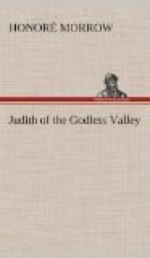Douglas sat tall in the saddle. He measured, in fact, a full five feet ten inches without his high-heeled riding-boots. He was so thin that his leather rider’s coat bellowed in the wind, and the modeling of his cheekbones showed markedly under his tanned skin. His sombrero, pushed back from his forehead, disclosed a thick thatch of bright yellow hair above wide blue eyes that were set deep and far apart. His nose was high bridged, and his mouth, though still immature, gave promise of full-lipped strength in its curves.
Judith was fourteen and only a couple of inches shorter than Douglas. She was even thinner than he, but, like him, glowing with intense vitality. She had hung her cap on the pommel of her saddle and her curly black hair whipped across her face. She had a short nose, a large mouth, magnificent gray eyes and cheeks of flawless carmine. She wore a faded plaid mackinaw, and arctics half-way up her long, thin legs.
“I hate you, Doug Spencer,” she said finally and fiercely, “and I’m glad you’re not my real brother!”
“I don’t see why my father ever married a woman with an ornery brat like you!” retorted Douglas.
“I wouldn’t stay to associate with you another minute if you offered me a new pair of spurs! I’m going to meet Maud!” And Judith disappeared down the trail.
Douglas eased back in his saddle and lighted a cigarette, while he watched the distant figures approaching across the valley. The glory of the landscape made little impression on him. He had been born in Lost Chief and he saw only snow and his schoolmates racing over the converging trails.
The Rockies in mid-winter! High northern cattle country with purple sage deep blanketed in snow, with rarefied air below the zero mark, with sky the purest, most crystalline deep sapphire, and Lost Chief Valley, high perched in the ranges, silently awaiting the return of spring.
Fire Mesa, huge, profoundly striated, with red clouds forever forming on its top and rolling over remoter mesas, stood with its greatest length across the north end of the valley. At its feet lay Black Gorge, and half-way up its steep red front projected the wide ledge on which the schoolhouse stood. Dead Line Peak and Falkner’s Peak abruptly closed the south end of the valley. From between these two great mountains, Lost Chief Creek swept down across the valley into the Black Gorge. Lost Chief Range formed the west boundary of the valley, Indian Range, the east. They were perhaps ten miles apart.
All this gives little of the picture Douglas might have been absorbing. It tells nothing of the azure hue of the snow that buried Lost Chief Creek and Lost Chief ranches. It gives no hint of the awful splendor of Dead Line and Falkner’s Peaks, all blue and bronze and crimson, backed by myriads of other peaks, pure white, against the perfect sky.
It does not picture the brilliant yellow canyon wall which thrust Lost Chief Range back from the valley, nor the peacock blue sides of the Indian Range, clothed in wonder by the Forest Reserve. And finally, it does not tell of the infinite silence that lay this prismatic Sunday afternoon over the snow-cloaked world.




